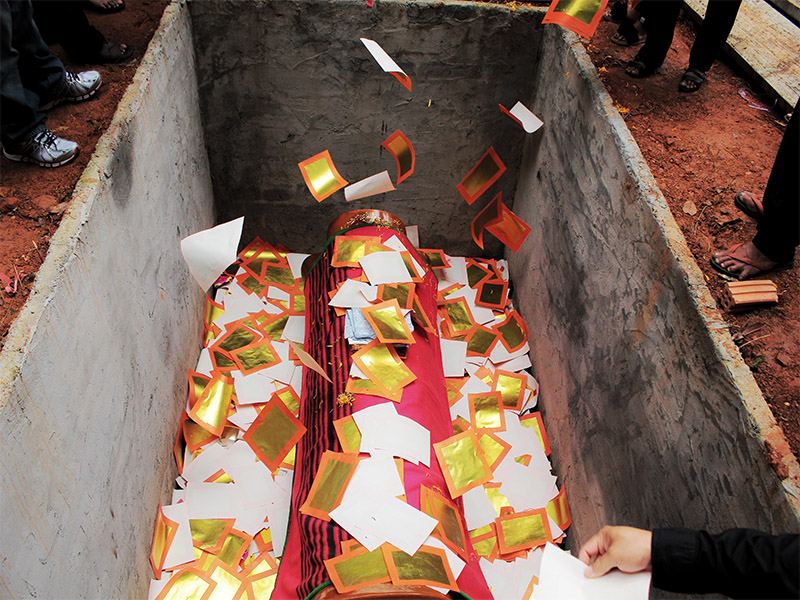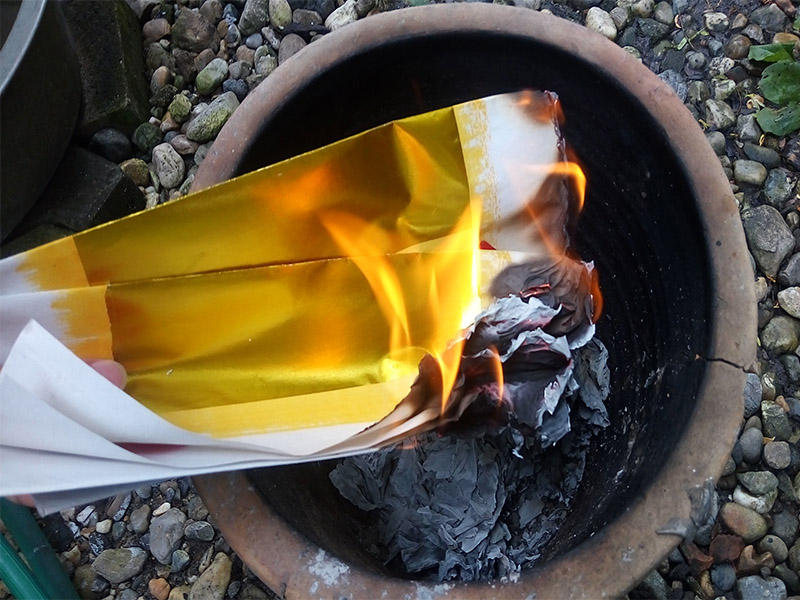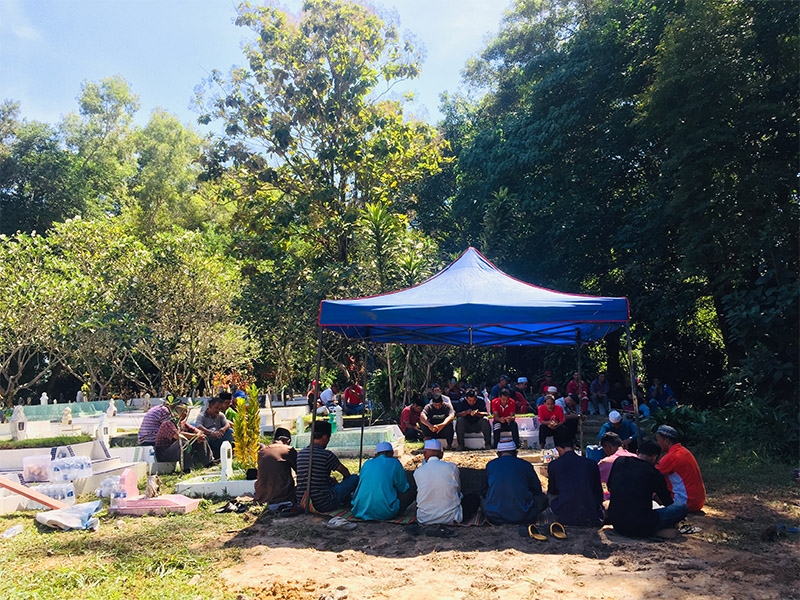One of the joys of living in Singapore is the mix of cultures. But if you lost a friend or a colleague, of a faith different than your own, would you know what to do?
Singapore is home to a wide variety of cultures, hosting an array of ceremonies and celebrations including special holidays, birth traditions, weddings and, yes, funerals. In all cultures, anybody is invited to the wake to pay respects, but each religion has very different traditions. While there are many variations in the practices, here’s what one can expect at each type of funeral.
Buddhism and Taoism
There is some overlap in the funeral rituals of these two religions. Wakes last three, five, seven or nine days. Families generally wear plain white T-shirts, black pants and coloured cloth badges, the different colours representing their relationship to the deceased. At a Buddhist wake and funeral, visitors will find a bucket of water with fresh flowers so they can “cleanse” themselves from the perceived negative association with the funeral.
Lengths of red thread are often found on the table, alongside refreshments. The threads are tied around the index finger or onto the middle button of the guest’s shirt near the chest to ensure safety from evil spirits. They are untied and thrown away upon leaving the service. If the funeral is held at the void deck of an HDB, red paper will be pasted on the stairways and lift landings to insulate neighbours from the presence of death.

Buddhists arrange a daily sutra chanting by monks from the deceased’s temple whereas, in the Taoist faith, priests conduct rituals the night before the funeral, generally lasting two to four hours. Paper effigies and joss paper money will be burnt on the same night. It’s believed that the spirits of the loved ones will receive these offerings and be able to put them to use in the netherworld. Paper offerings are not generally part of the Buddhist tradition.
On the day of the funeral, the Buddhist monk or Taoist priest conducts a final prayer and chanting and the final viewing is held at the wake. Attendees hold incense sticks and pay respects at the altar, but this is not mandatory.
Japanese Buddhists do it slightly differently. After cremation, the relatives use giant chopsticks to pick the bones out of the ashes to put into an urn, starting with the feet and ending with the head, the neck’s hyoid bone being most important. This is the only time that two people may pick up the same thing with chopsticks in Japanese culture.

Protestantism and Catholicism
Funerals can take place several days after death, allowing for family members to arrive. In the days before the service, close family and friends visit to offer comfort, often bringing food to the family. The ministry will offer remembrances and prayers at worship services. Flowers can be sent to the home of the bereaved or the wake venue.
The day before the service, an official visitation to pay respects to the family is often held at the funeral home. In some cultures, a prayer service is held the night before at the church. On the day of the funeral, a memorial service or mass will be conducted at the local church before the funeral procession departs for the cemetery or crematorium. These services are simple, solemn affairs, celebrating the belief in the afterlife as promised by Jesus Christ. Attendees usually wear dark business attire.
Filipinos have slightly different beliefs. The beloved is to be kept in the home for nine days up to three weeks. The family provides small snacks such as peanuts while the family and friends sing songs and play games such as mahjong to stay awake. The winners tithe part of their monies to the bereaved families to help cover funeral costs. If your helper has a death in the family, you can offer to pay for her ticket home or pay for a portion of the cost of the funeral.

Judaism
Jews observe a week-long mourning called shiva. To eliminate any chance of distracting the mourner from concentrating on the deceased, all mirrors in the home are covered (no temptation to check makeup or preen hair!). Women sit shiva in one room and men in another. Visitors come to pay respects, bringing food such as bread, but not flowers.
The deceased is washed and prepared for burial, which is to be as soon as possible, though may be delayed to allow family members to arrive. Funeral attendees should wear dark colours and family members wear black ribbons (Orthodox Jews make small tears in their clothes). The ribbon is traditionally worn on the outer garment for the period of shiva. Family members have specific roles to perform both in the funeral service and in the days preceding and months following the funeral. There is never an open casket or cremation and the casket is always simple and biodegradable as Jews believe it’s important for the body to be able to return to Earth.
Following the internment, mourners return to shiva. In some communities, the congregation form two parallel lines facing each other and the mourners pass between while special words are recited, before all return to the home.
Islam
When somebody dies in the Islamic faith, it’s seen as not only a loss to the family, but to the whole Muslim community. Therefore, Muslims are encouraged to attend funerals.
Muslims wash the deceased following a very specific order, shroud the body, and perform funeral prayers before the burial. Embalming and cosmetology are not allowed unless required by law. The deceased is usually buried in the country of death and the burial often takes place within 24 hours after death, preferably before the sun sets. The entire family participates in prayers, known as Salat al-Janazah, and families often offer lamentations. Traditionally, only men are allowed at the burial, but in Singapore all mourners are allowed to be present.
Muslim graves are built at a right angle to the direction of the Kaaba in Mecca, the holiest site in Islam. After the burial, the immediate family receives visitors. It’s strongly encouraged for the community to provide food for the family on the day of the funeral.

Hinduism
When possible, Hindus prefer to die at home, surrounded by loved ones. The deceased remains at the home (or is brought home) until cremation, usually within 24 hours after death. An open casket is present there, with a priest presiding over proceedings. Hymns and mantras are recited, and some services include a fire sacrifice. Offerings are made to ancestors and gods. Flowers may be offered, but bringing food is not part of the Hindu culture.
Up until 10 or 15 years ago, only men would go to the cremation site, led by the chief mourner. Today, more women are attending for the final farewell. Attendees can dress casually and should wear white; black is considered inappropriate. Ten days later, a special ceremony is held at the home of the deceased to liberate the soul. Visitors are expected to bring fruit.
Ashes should be scattered over sacred water; some families in Singapore are opting to take their loved ones’ ashes to the sacred Ganges River in India. This is the Hindu practice of antim samskara or end-of-life purification. It’s believed that immersing the ashes in the river Ganges helps the soul attain liberation from material bondage.
Sikhism
In the Sikh religion, the deceased is washed with water, yoghurt and soap before being placed in a casket. While lying in state, prayer recordings (kirtan) are played continually, followed by a short set prayer (ardaas), before the casket is loaded into the hearse and taken to the crematorium. When being placed into the hearse, the feet must go in first.
At the crematorium, the casket is placed in the middle of the hall to allow family members to pay their last respects. Beginning with the ladies, they will place flowers on the deceased and offer their condolences to the immediate family, who may stand in line besides the casket. Attendees should wear white.
The ardaas is recited again, before permission is sought from the Almighty to cremate the deceased. Family members gather around the casket one last time. After the cremation, the family and congregation proceed to the Gurdwara (Sikh temple) where a simple meal of rice, dhal and tea may be served.
What to send
Many people send wreaths, flowers and banners to a funeral wake of a person of ethnic Chinese origin. These banners – large pieces of multi-coloured cloth with laudatory words, and the names of the contributors written on the side – are prominently displayed at the site of the funeral. Hindu families also accept wreaths, but Muslims and Jews do not.
It’s also the practice to give condolence money, known as “white gold”, as a means to assist with the costs of the funeral. There is no fixed value and it’s often seen as a token to the family. It depends very much on the relationship of the guest to the deceased and the family of the deceased. Such a practice is not found in the Muslim, Hindu, Jewish or some Christian communities.
To learn more about funeral rites in Singapore or to arrange a service, reach out to Ang Chin Moh Funeral Directors at angchinmoh.com.sg.
For more helpful tips, head to our Living in Singapore section.
Animals up for adoption
Top barbers and hair salons sorted!
28 preschools and kindergartens reviewed
This article first appeared in the April 2019 edition of Expat Living. You can purchase a copy or subscribe so you never miss an issue!



